Assessing Employee Participation in Management Decision Making at Ford
VerifiedAdded on 2020/06/05
|13
|4148
|125
Report
AI Summary
This report investigates the impact of employee participation in management decision-making at Ford Motor Company. It begins with an introduction to Ford and the importance of employee engagement, followed by a review of literature exploring the benefits and methods of employee involvement in decision-making processes. The research objectives aim to analyze the ways employees participate, assess the impact of their involvement, and provide recommendations for improvement. The methodology employs a descriptive research design, collecting data to address research questions and test hypotheses. The report examines the significance of the research and concludes with recommendations for enhancing employee participation and its influence on Ford's organizational performance and productivity. This report provides valuable insights for managers and stakeholders interested in improving employee engagement and decision-making processes within the company.
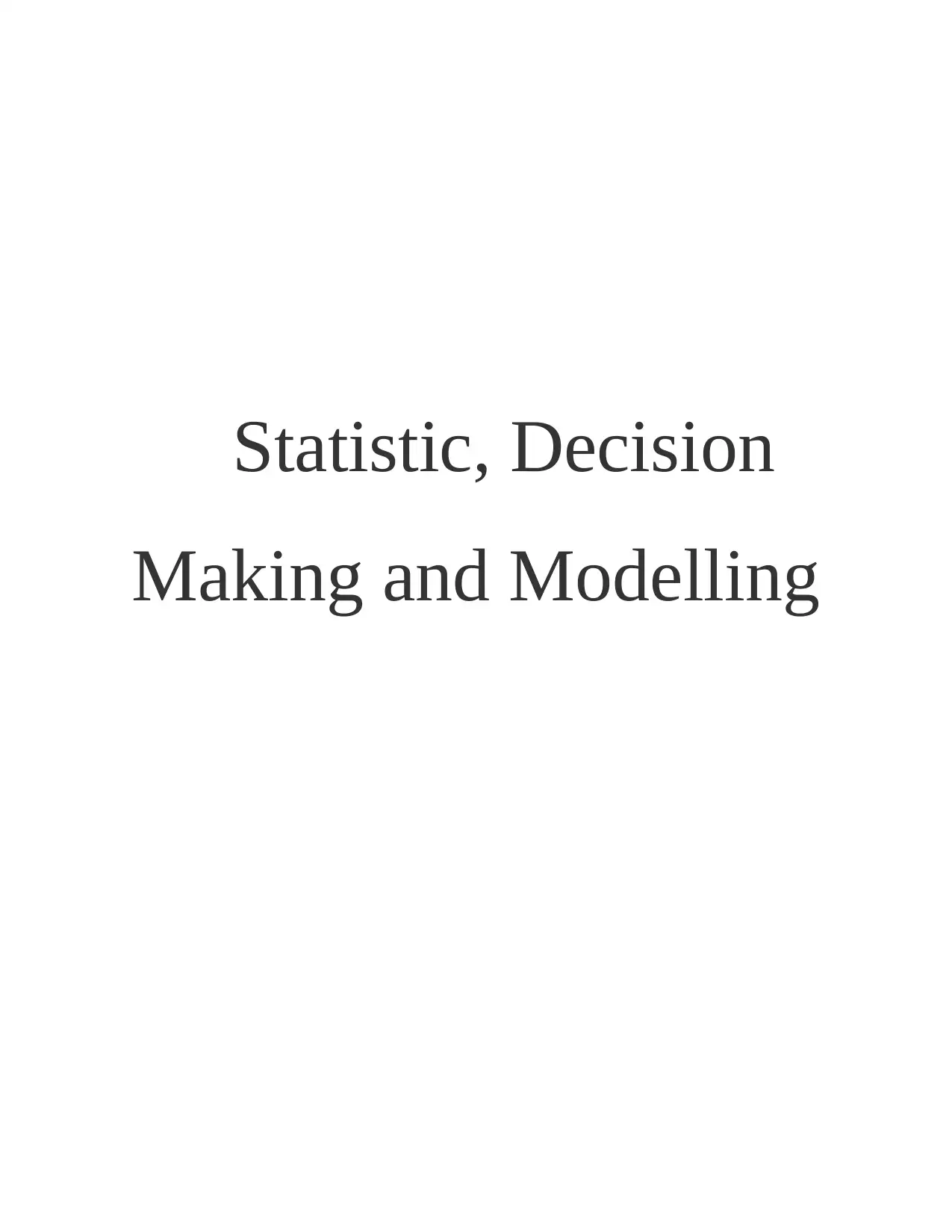
Statistic, Decision
Making and Modelling
Making and Modelling
Paraphrase This Document
Need a fresh take? Get an instant paraphrase of this document with our AI Paraphraser
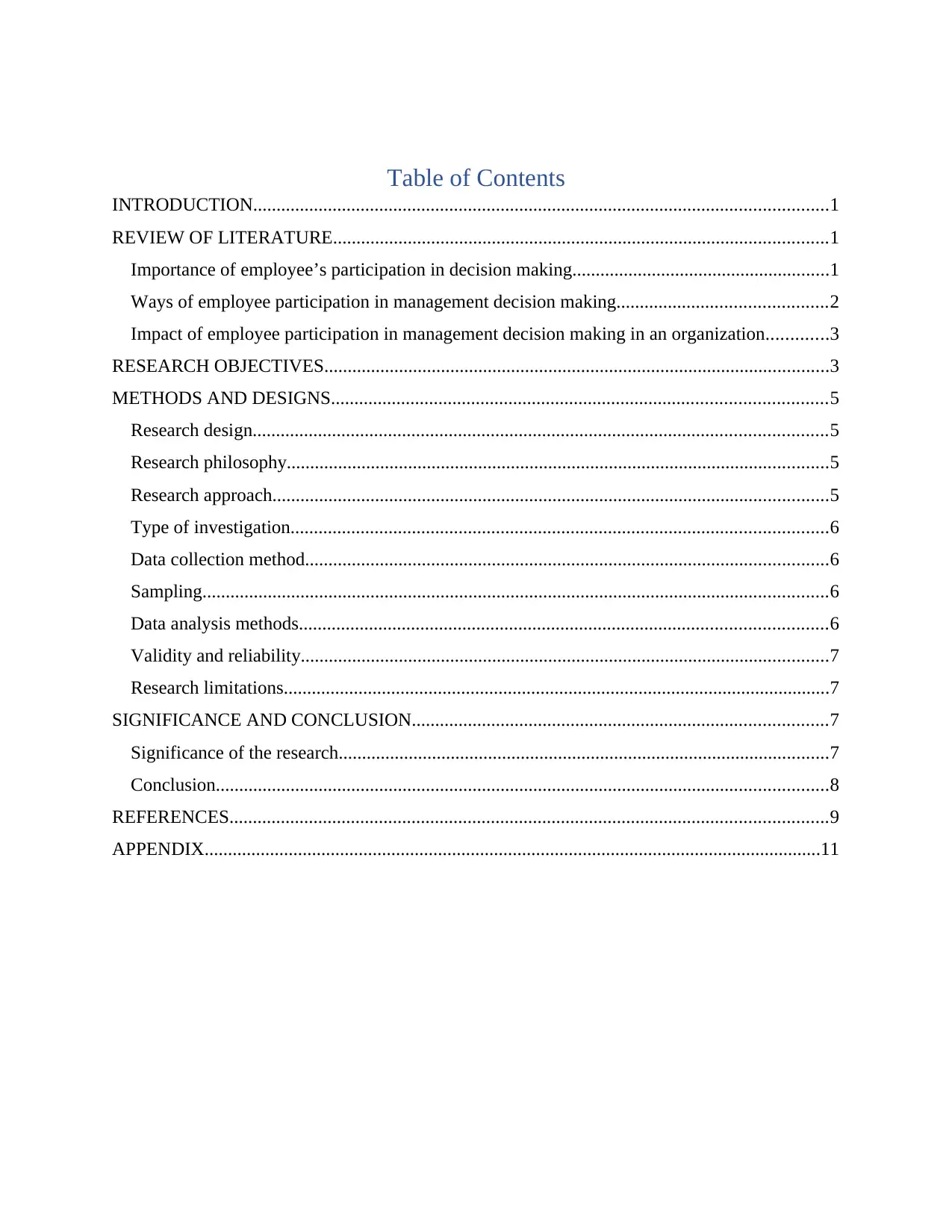
Table of Contents
INTRODUCTION...........................................................................................................................1
REVIEW OF LITERATURE..........................................................................................................1
Importance of employee’s participation in decision making.......................................................1
Ways of employee participation in management decision making.............................................2
Impact of employee participation in management decision making in an organization.............3
RESEARCH OBJECTIVES............................................................................................................3
METHODS AND DESIGNS..........................................................................................................5
Research design...........................................................................................................................5
Research philosophy....................................................................................................................5
Research approach.......................................................................................................................5
Type of investigation...................................................................................................................6
Data collection method................................................................................................................6
Sampling......................................................................................................................................6
Data analysis methods.................................................................................................................6
Validity and reliability.................................................................................................................7
Research limitations.....................................................................................................................7
SIGNIFICANCE AND CONCLUSION.........................................................................................7
Significance of the research.........................................................................................................7
Conclusion...................................................................................................................................8
REFERENCES................................................................................................................................9
APPENDIX....................................................................................................................................11
INTRODUCTION...........................................................................................................................1
REVIEW OF LITERATURE..........................................................................................................1
Importance of employee’s participation in decision making.......................................................1
Ways of employee participation in management decision making.............................................2
Impact of employee participation in management decision making in an organization.............3
RESEARCH OBJECTIVES............................................................................................................3
METHODS AND DESIGNS..........................................................................................................5
Research design...........................................................................................................................5
Research philosophy....................................................................................................................5
Research approach.......................................................................................................................5
Type of investigation...................................................................................................................6
Data collection method................................................................................................................6
Sampling......................................................................................................................................6
Data analysis methods.................................................................................................................6
Validity and reliability.................................................................................................................7
Research limitations.....................................................................................................................7
SIGNIFICANCE AND CONCLUSION.........................................................................................7
Significance of the research.........................................................................................................7
Conclusion...................................................................................................................................8
REFERENCES................................................................................................................................9
APPENDIX....................................................................................................................................11
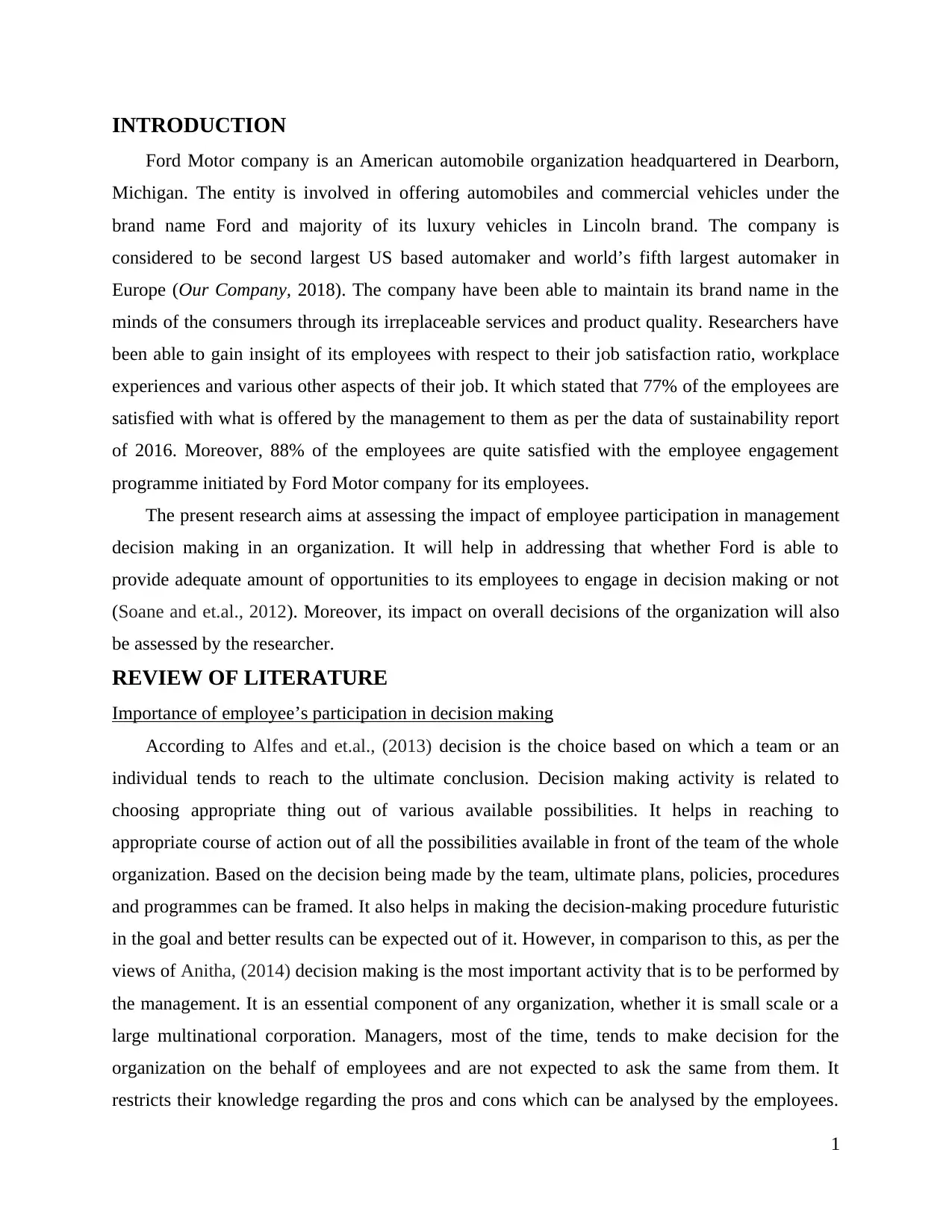
INTRODUCTION
Ford Motor company is an American automobile organization headquartered in Dearborn,
Michigan. The entity is involved in offering automobiles and commercial vehicles under the
brand name Ford and majority of its luxury vehicles in Lincoln brand. The company is
considered to be second largest US based automaker and world’s fifth largest automaker in
Europe (Our Company, 2018). The company have been able to maintain its brand name in the
minds of the consumers through its irreplaceable services and product quality. Researchers have
been able to gain insight of its employees with respect to their job satisfaction ratio, workplace
experiences and various other aspects of their job. It which stated that 77% of the employees are
satisfied with what is offered by the management to them as per the data of sustainability report
of 2016. Moreover, 88% of the employees are quite satisfied with the employee engagement
programme initiated by Ford Motor company for its employees.
The present research aims at assessing the impact of employee participation in management
decision making in an organization. It will help in addressing that whether Ford is able to
provide adequate amount of opportunities to its employees to engage in decision making or not
(Soane and et.al., 2012). Moreover, its impact on overall decisions of the organization will also
be assessed by the researcher.
REVIEW OF LITERATURE
Importance of employee’s participation in decision making
According to Alfes and et.al., (2013) decision is the choice based on which a team or an
individual tends to reach to the ultimate conclusion. Decision making activity is related to
choosing appropriate thing out of various available possibilities. It helps in reaching to
appropriate course of action out of all the possibilities available in front of the team of the whole
organization. Based on the decision being made by the team, ultimate plans, policies, procedures
and programmes can be framed. It also helps in making the decision-making procedure futuristic
in the goal and better results can be expected out of it. However, in comparison to this, as per the
views of Anitha, (2014) decision making is the most important activity that is to be performed by
the management. It is an essential component of any organization, whether it is small scale or a
large multinational corporation. Managers, most of the time, tends to make decision for the
organization on the behalf of employees and are not expected to ask the same from them. It
restricts their knowledge regarding the pros and cons which can be analysed by the employees.
1
Ford Motor company is an American automobile organization headquartered in Dearborn,
Michigan. The entity is involved in offering automobiles and commercial vehicles under the
brand name Ford and majority of its luxury vehicles in Lincoln brand. The company is
considered to be second largest US based automaker and world’s fifth largest automaker in
Europe (Our Company, 2018). The company have been able to maintain its brand name in the
minds of the consumers through its irreplaceable services and product quality. Researchers have
been able to gain insight of its employees with respect to their job satisfaction ratio, workplace
experiences and various other aspects of their job. It which stated that 77% of the employees are
satisfied with what is offered by the management to them as per the data of sustainability report
of 2016. Moreover, 88% of the employees are quite satisfied with the employee engagement
programme initiated by Ford Motor company for its employees.
The present research aims at assessing the impact of employee participation in management
decision making in an organization. It will help in addressing that whether Ford is able to
provide adequate amount of opportunities to its employees to engage in decision making or not
(Soane and et.al., 2012). Moreover, its impact on overall decisions of the organization will also
be assessed by the researcher.
REVIEW OF LITERATURE
Importance of employee’s participation in decision making
According to Alfes and et.al., (2013) decision is the choice based on which a team or an
individual tends to reach to the ultimate conclusion. Decision making activity is related to
choosing appropriate thing out of various available possibilities. It helps in reaching to
appropriate course of action out of all the possibilities available in front of the team of the whole
organization. Based on the decision being made by the team, ultimate plans, policies, procedures
and programmes can be framed. It also helps in making the decision-making procedure futuristic
in the goal and better results can be expected out of it. However, in comparison to this, as per the
views of Anitha, (2014) decision making is the most important activity that is to be performed by
the management. It is an essential component of any organization, whether it is small scale or a
large multinational corporation. Managers, most of the time, tends to make decision for the
organization on the behalf of employees and are not expected to ask the same from them. It
restricts their knowledge regarding the pros and cons which can be analysed by the employees.
1
⊘ This is a preview!⊘
Do you want full access?
Subscribe today to unlock all pages.

Trusted by 1+ million students worldwide
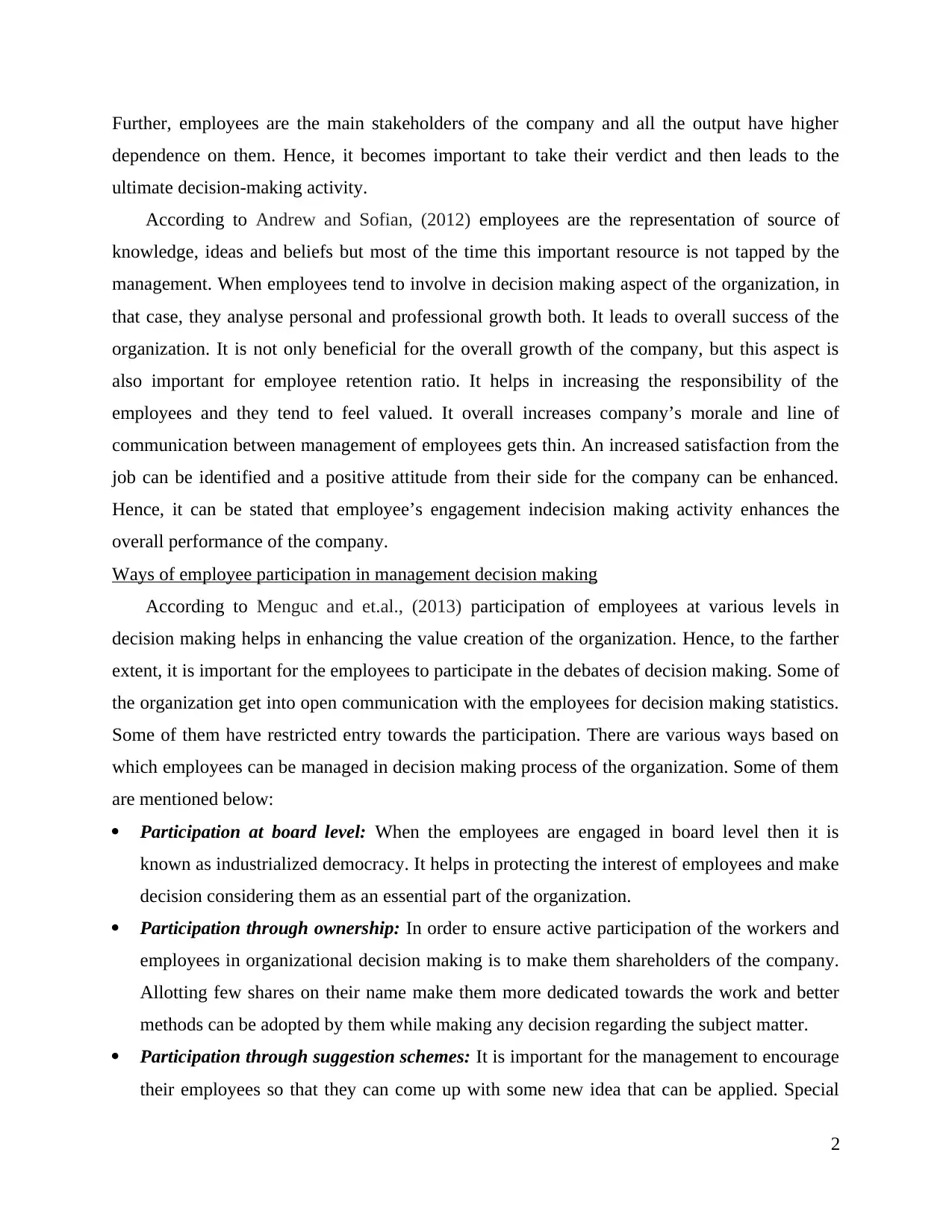
Further, employees are the main stakeholders of the company and all the output have higher
dependence on them. Hence, it becomes important to take their verdict and then leads to the
ultimate decision-making activity.
According to Andrew and Sofian, (2012) employees are the representation of source of
knowledge, ideas and beliefs but most of the time this important resource is not tapped by the
management. When employees tend to involve in decision making aspect of the organization, in
that case, they analyse personal and professional growth both. It leads to overall success of the
organization. It is not only beneficial for the overall growth of the company, but this aspect is
also important for employee retention ratio. It helps in increasing the responsibility of the
employees and they tend to feel valued. It overall increases company’s morale and line of
communication between management of employees gets thin. An increased satisfaction from the
job can be identified and a positive attitude from their side for the company can be enhanced.
Hence, it can be stated that employee’s engagement indecision making activity enhances the
overall performance of the company.
Ways of employee participation in management decision making
According to Menguc and et.al., (2013) participation of employees at various levels in
decision making helps in enhancing the value creation of the organization. Hence, to the farther
extent, it is important for the employees to participate in the debates of decision making. Some of
the organization get into open communication with the employees for decision making statistics.
Some of them have restricted entry towards the participation. There are various ways based on
which employees can be managed in decision making process of the organization. Some of them
are mentioned below:
Participation at board level: When the employees are engaged in board level then it is
known as industrialized democracy. It helps in protecting the interest of employees and make
decision considering them as an essential part of the organization.
Participation through ownership: In order to ensure active participation of the workers and
employees in organizational decision making is to make them shareholders of the company.
Allotting few shares on their name make them more dedicated towards the work and better
methods can be adopted by them while making any decision regarding the subject matter.
Participation through suggestion schemes: It is important for the management to encourage
their employees so that they can come up with some new idea that can be applied. Special
2
dependence on them. Hence, it becomes important to take their verdict and then leads to the
ultimate decision-making activity.
According to Andrew and Sofian, (2012) employees are the representation of source of
knowledge, ideas and beliefs but most of the time this important resource is not tapped by the
management. When employees tend to involve in decision making aspect of the organization, in
that case, they analyse personal and professional growth both. It leads to overall success of the
organization. It is not only beneficial for the overall growth of the company, but this aspect is
also important for employee retention ratio. It helps in increasing the responsibility of the
employees and they tend to feel valued. It overall increases company’s morale and line of
communication between management of employees gets thin. An increased satisfaction from the
job can be identified and a positive attitude from their side for the company can be enhanced.
Hence, it can be stated that employee’s engagement indecision making activity enhances the
overall performance of the company.
Ways of employee participation in management decision making
According to Menguc and et.al., (2013) participation of employees at various levels in
decision making helps in enhancing the value creation of the organization. Hence, to the farther
extent, it is important for the employees to participate in the debates of decision making. Some of
the organization get into open communication with the employees for decision making statistics.
Some of them have restricted entry towards the participation. There are various ways based on
which employees can be managed in decision making process of the organization. Some of them
are mentioned below:
Participation at board level: When the employees are engaged in board level then it is
known as industrialized democracy. It helps in protecting the interest of employees and make
decision considering them as an essential part of the organization.
Participation through ownership: In order to ensure active participation of the workers and
employees in organizational decision making is to make them shareholders of the company.
Allotting few shares on their name make them more dedicated towards the work and better
methods can be adopted by them while making any decision regarding the subject matter.
Participation through suggestion schemes: It is important for the management to encourage
their employees so that they can come up with some new idea that can be applied. Special
2
Paraphrase This Document
Need a fresh take? Get an instant paraphrase of this document with our AI Paraphraser
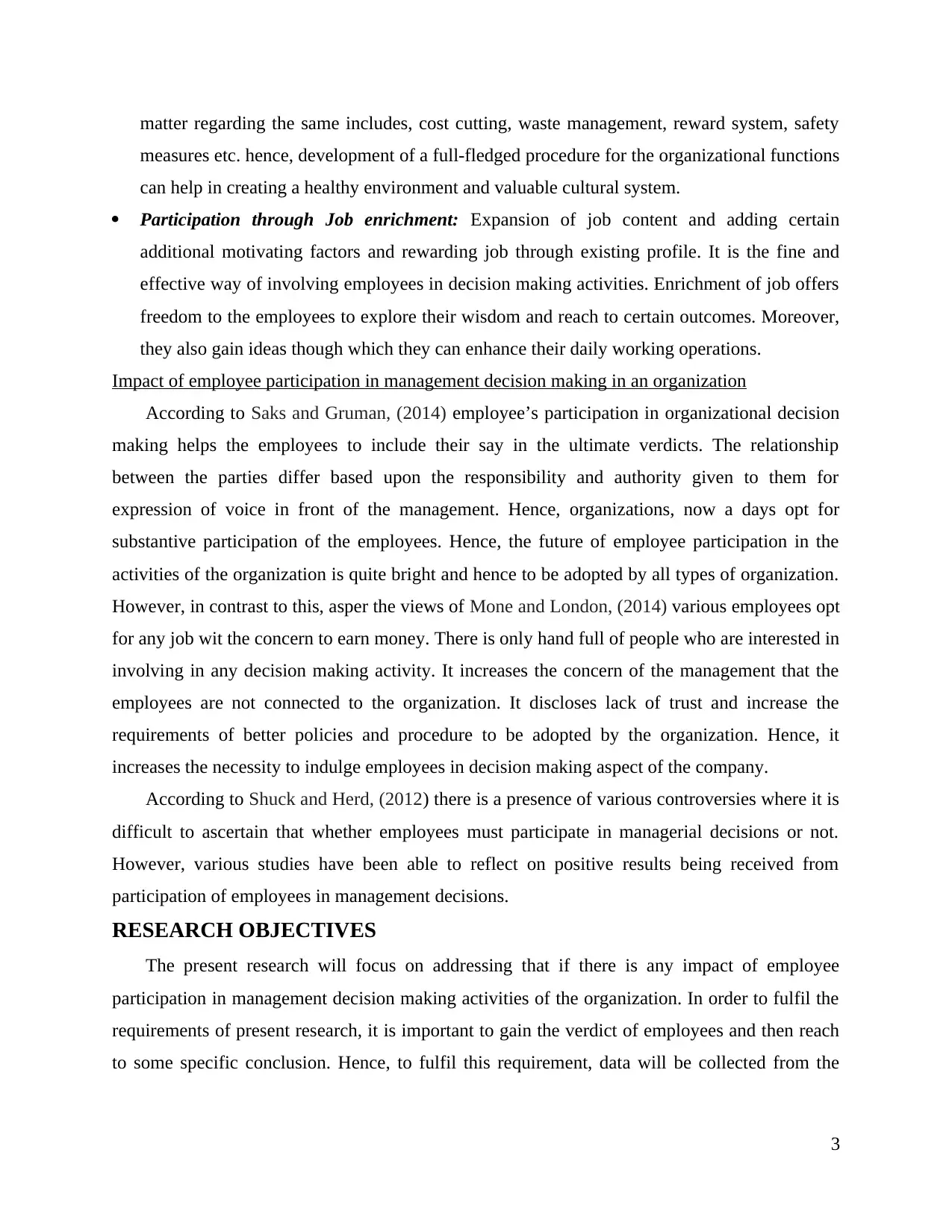
matter regarding the same includes, cost cutting, waste management, reward system, safety
measures etc. hence, development of a full-fledged procedure for the organizational functions
can help in creating a healthy environment and valuable cultural system.
Participation through Job enrichment: Expansion of job content and adding certain
additional motivating factors and rewarding job through existing profile. It is the fine and
effective way of involving employees in decision making activities. Enrichment of job offers
freedom to the employees to explore their wisdom and reach to certain outcomes. Moreover,
they also gain ideas though which they can enhance their daily working operations.
Impact of employee participation in management decision making in an organization
According to Saks and Gruman, (2014) employee’s participation in organizational decision
making helps the employees to include their say in the ultimate verdicts. The relationship
between the parties differ based upon the responsibility and authority given to them for
expression of voice in front of the management. Hence, organizations, now a days opt for
substantive participation of the employees. Hence, the future of employee participation in the
activities of the organization is quite bright and hence to be adopted by all types of organization.
However, in contrast to this, asper the views of Mone and London, (2014) various employees opt
for any job wit the concern to earn money. There is only hand full of people who are interested in
involving in any decision making activity. It increases the concern of the management that the
employees are not connected to the organization. It discloses lack of trust and increase the
requirements of better policies and procedure to be adopted by the organization. Hence, it
increases the necessity to indulge employees in decision making aspect of the company.
According to Shuck and Herd, (2012) there is a presence of various controversies where it is
difficult to ascertain that whether employees must participate in managerial decisions or not.
However, various studies have been able to reflect on positive results being received from
participation of employees in management decisions.
RESEARCH OBJECTIVES
The present research will focus on addressing that if there is any impact of employee
participation in management decision making activities of the organization. In order to fulfil the
requirements of present research, it is important to gain the verdict of employees and then reach
to some specific conclusion. Hence, to fulfil this requirement, data will be collected from the
3
measures etc. hence, development of a full-fledged procedure for the organizational functions
can help in creating a healthy environment and valuable cultural system.
Participation through Job enrichment: Expansion of job content and adding certain
additional motivating factors and rewarding job through existing profile. It is the fine and
effective way of involving employees in decision making activities. Enrichment of job offers
freedom to the employees to explore their wisdom and reach to certain outcomes. Moreover,
they also gain ideas though which they can enhance their daily working operations.
Impact of employee participation in management decision making in an organization
According to Saks and Gruman, (2014) employee’s participation in organizational decision
making helps the employees to include their say in the ultimate verdicts. The relationship
between the parties differ based upon the responsibility and authority given to them for
expression of voice in front of the management. Hence, organizations, now a days opt for
substantive participation of the employees. Hence, the future of employee participation in the
activities of the organization is quite bright and hence to be adopted by all types of organization.
However, in contrast to this, asper the views of Mone and London, (2014) various employees opt
for any job wit the concern to earn money. There is only hand full of people who are interested in
involving in any decision making activity. It increases the concern of the management that the
employees are not connected to the organization. It discloses lack of trust and increase the
requirements of better policies and procedure to be adopted by the organization. Hence, it
increases the necessity to indulge employees in decision making aspect of the company.
According to Shuck and Herd, (2012) there is a presence of various controversies where it is
difficult to ascertain that whether employees must participate in managerial decisions or not.
However, various studies have been able to reflect on positive results being received from
participation of employees in management decisions.
RESEARCH OBJECTIVES
The present research will focus on addressing that if there is any impact of employee
participation in management decision making activities of the organization. In order to fulfil the
requirements of present research, it is important to gain the verdict of employees and then reach
to some specific conclusion. Hence, to fulfil this requirement, data will be collected from the
3
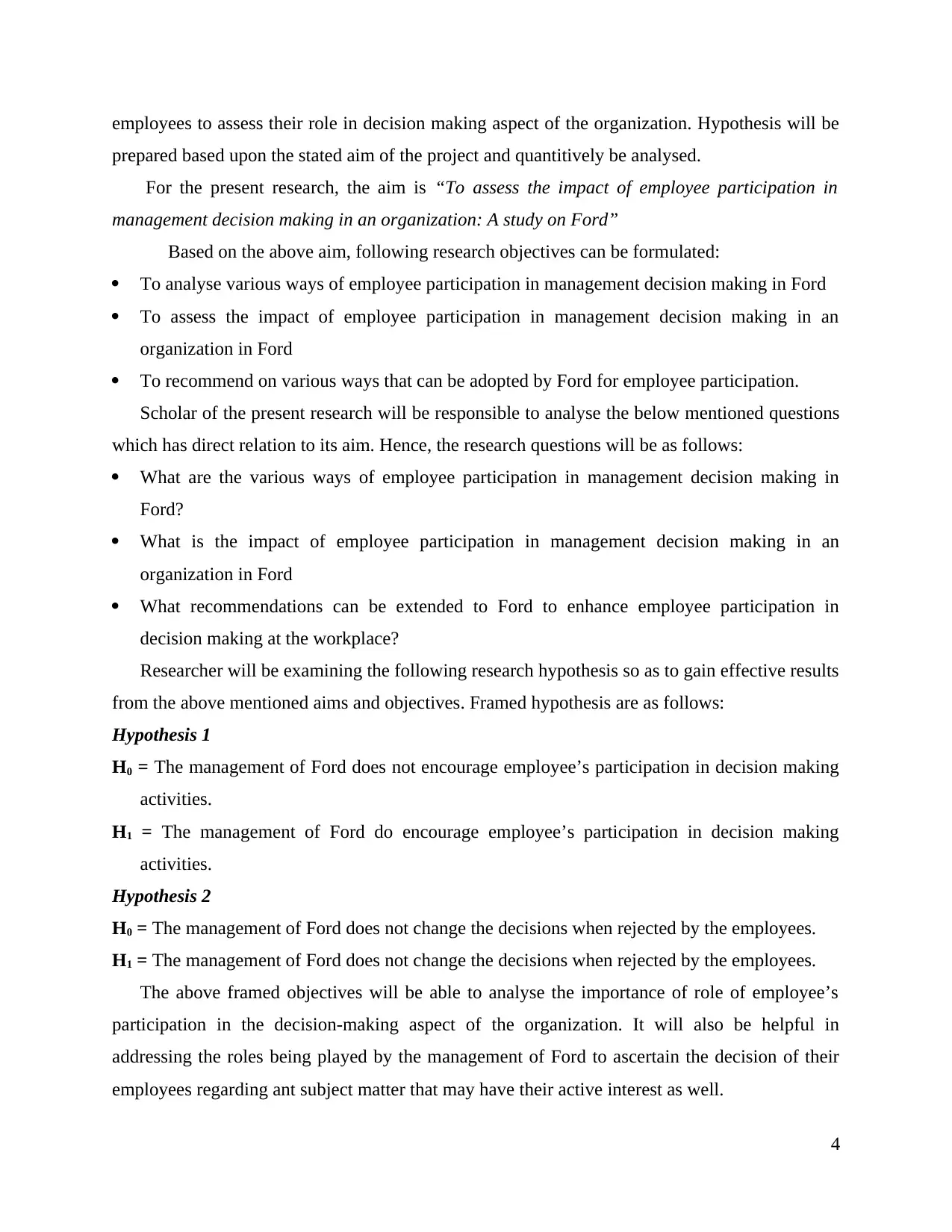
employees to assess their role in decision making aspect of the organization. Hypothesis will be
prepared based upon the stated aim of the project and quantitively be analysed.
For the present research, the aim is “To assess the impact of employee participation in
management decision making in an organization: A study on Ford”
Based on the above aim, following research objectives can be formulated:
To analyse various ways of employee participation in management decision making in Ford
To assess the impact of employee participation in management decision making in an
organization in Ford
To recommend on various ways that can be adopted by Ford for employee participation.
Scholar of the present research will be responsible to analyse the below mentioned questions
which has direct relation to its aim. Hence, the research questions will be as follows:
What are the various ways of employee participation in management decision making in
Ford?
What is the impact of employee participation in management decision making in an
organization in Ford
What recommendations can be extended to Ford to enhance employee participation in
decision making at the workplace?
Researcher will be examining the following research hypothesis so as to gain effective results
from the above mentioned aims and objectives. Framed hypothesis are as follows:
Hypothesis 1
H0 = The management of Ford does not encourage employee’s participation in decision making
activities.
H1 = The management of Ford do encourage employee’s participation in decision making
activities.
Hypothesis 2
H0 = The management of Ford does not change the decisions when rejected by the employees.
H1 = The management of Ford does not change the decisions when rejected by the employees.
The above framed objectives will be able to analyse the importance of role of employee’s
participation in the decision-making aspect of the organization. It will also be helpful in
addressing the roles being played by the management of Ford to ascertain the decision of their
employees regarding ant subject matter that may have their active interest as well.
4
prepared based upon the stated aim of the project and quantitively be analysed.
For the present research, the aim is “To assess the impact of employee participation in
management decision making in an organization: A study on Ford”
Based on the above aim, following research objectives can be formulated:
To analyse various ways of employee participation in management decision making in Ford
To assess the impact of employee participation in management decision making in an
organization in Ford
To recommend on various ways that can be adopted by Ford for employee participation.
Scholar of the present research will be responsible to analyse the below mentioned questions
which has direct relation to its aim. Hence, the research questions will be as follows:
What are the various ways of employee participation in management decision making in
Ford?
What is the impact of employee participation in management decision making in an
organization in Ford
What recommendations can be extended to Ford to enhance employee participation in
decision making at the workplace?
Researcher will be examining the following research hypothesis so as to gain effective results
from the above mentioned aims and objectives. Framed hypothesis are as follows:
Hypothesis 1
H0 = The management of Ford does not encourage employee’s participation in decision making
activities.
H1 = The management of Ford do encourage employee’s participation in decision making
activities.
Hypothesis 2
H0 = The management of Ford does not change the decisions when rejected by the employees.
H1 = The management of Ford does not change the decisions when rejected by the employees.
The above framed objectives will be able to analyse the importance of role of employee’s
participation in the decision-making aspect of the organization. It will also be helpful in
addressing the roles being played by the management of Ford to ascertain the decision of their
employees regarding ant subject matter that may have their active interest as well.
4
⊘ This is a preview!⊘
Do you want full access?
Subscribe today to unlock all pages.

Trusted by 1+ million students worldwide
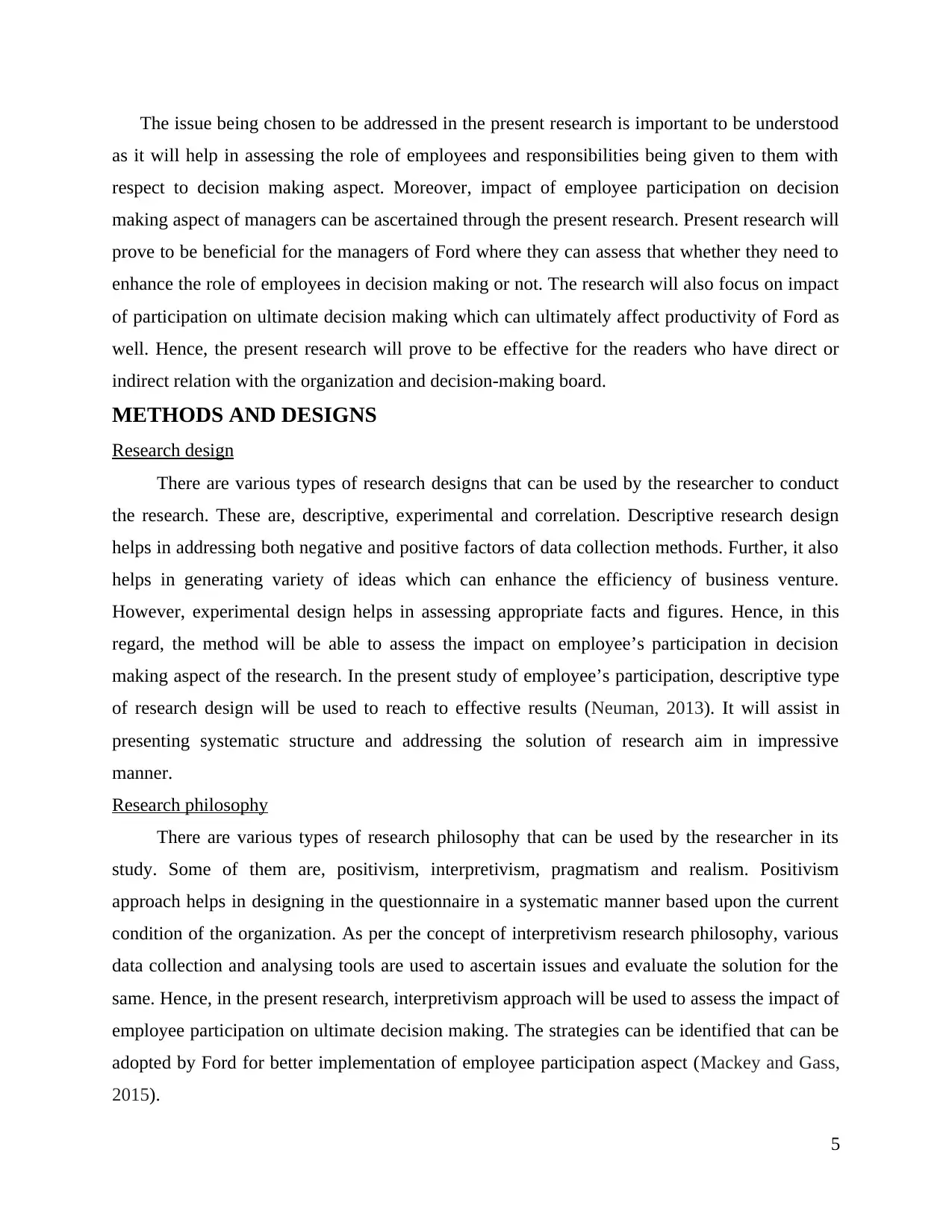
The issue being chosen to be addressed in the present research is important to be understood
as it will help in assessing the role of employees and responsibilities being given to them with
respect to decision making aspect. Moreover, impact of employee participation on decision
making aspect of managers can be ascertained through the present research. Present research will
prove to be beneficial for the managers of Ford where they can assess that whether they need to
enhance the role of employees in decision making or not. The research will also focus on impact
of participation on ultimate decision making which can ultimately affect productivity of Ford as
well. Hence, the present research will prove to be effective for the readers who have direct or
indirect relation with the organization and decision-making board.
METHODS AND DESIGNS
Research design
There are various types of research designs that can be used by the researcher to conduct
the research. These are, descriptive, experimental and correlation. Descriptive research design
helps in addressing both negative and positive factors of data collection methods. Further, it also
helps in generating variety of ideas which can enhance the efficiency of business venture.
However, experimental design helps in assessing appropriate facts and figures. Hence, in this
regard, the method will be able to assess the impact on employee’s participation in decision
making aspect of the research. In the present study of employee’s participation, descriptive type
of research design will be used to reach to effective results (Neuman, 2013). It will assist in
presenting systematic structure and addressing the solution of research aim in impressive
manner.
Research philosophy
There are various types of research philosophy that can be used by the researcher in its
study. Some of them are, positivism, interpretivism, pragmatism and realism. Positivism
approach helps in designing in the questionnaire in a systematic manner based upon the current
condition of the organization. As per the concept of interpretivism research philosophy, various
data collection and analysing tools are used to ascertain issues and evaluate the solution for the
same. Hence, in the present research, interpretivism approach will be used to assess the impact of
employee participation on ultimate decision making. The strategies can be identified that can be
adopted by Ford for better implementation of employee participation aspect (Mackey and Gass,
2015).
5
as it will help in assessing the role of employees and responsibilities being given to them with
respect to decision making aspect. Moreover, impact of employee participation on decision
making aspect of managers can be ascertained through the present research. Present research will
prove to be beneficial for the managers of Ford where they can assess that whether they need to
enhance the role of employees in decision making or not. The research will also focus on impact
of participation on ultimate decision making which can ultimately affect productivity of Ford as
well. Hence, the present research will prove to be effective for the readers who have direct or
indirect relation with the organization and decision-making board.
METHODS AND DESIGNS
Research design
There are various types of research designs that can be used by the researcher to conduct
the research. These are, descriptive, experimental and correlation. Descriptive research design
helps in addressing both negative and positive factors of data collection methods. Further, it also
helps in generating variety of ideas which can enhance the efficiency of business venture.
However, experimental design helps in assessing appropriate facts and figures. Hence, in this
regard, the method will be able to assess the impact on employee’s participation in decision
making aspect of the research. In the present study of employee’s participation, descriptive type
of research design will be used to reach to effective results (Neuman, 2013). It will assist in
presenting systematic structure and addressing the solution of research aim in impressive
manner.
Research philosophy
There are various types of research philosophy that can be used by the researcher in its
study. Some of them are, positivism, interpretivism, pragmatism and realism. Positivism
approach helps in designing in the questionnaire in a systematic manner based upon the current
condition of the organization. As per the concept of interpretivism research philosophy, various
data collection and analysing tools are used to ascertain issues and evaluate the solution for the
same. Hence, in the present research, interpretivism approach will be used to assess the impact of
employee participation on ultimate decision making. The strategies can be identified that can be
adopted by Ford for better implementation of employee participation aspect (Mackey and Gass,
2015).
5
Paraphrase This Document
Need a fresh take? Get an instant paraphrase of this document with our AI Paraphraser
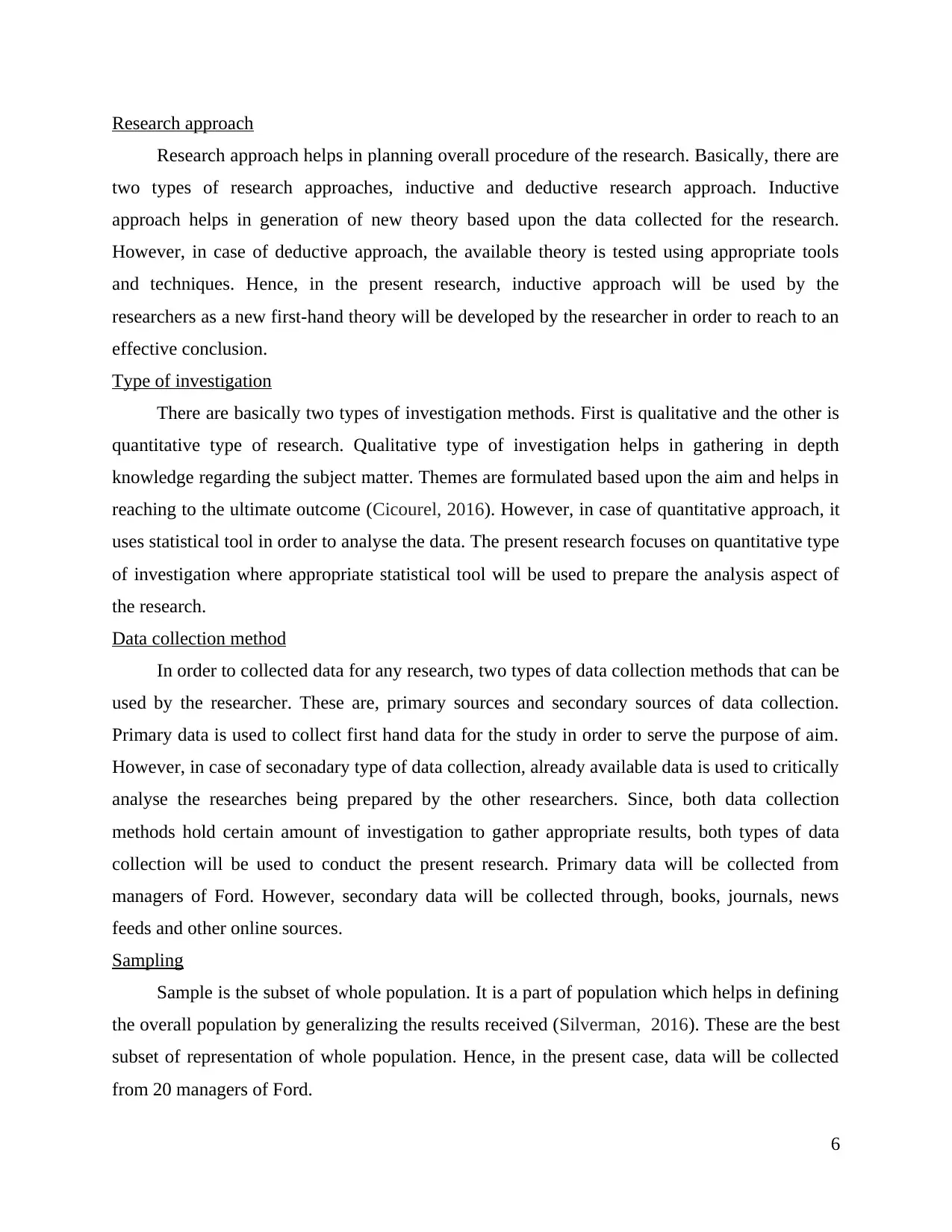
Research approach
Research approach helps in planning overall procedure of the research. Basically, there are
two types of research approaches, inductive and deductive research approach. Inductive
approach helps in generation of new theory based upon the data collected for the research.
However, in case of deductive approach, the available theory is tested using appropriate tools
and techniques. Hence, in the present research, inductive approach will be used by the
researchers as a new first-hand theory will be developed by the researcher in order to reach to an
effective conclusion.
Type of investigation
There are basically two types of investigation methods. First is qualitative and the other is
quantitative type of research. Qualitative type of investigation helps in gathering in depth
knowledge regarding the subject matter. Themes are formulated based upon the aim and helps in
reaching to the ultimate outcome (Cicourel, 2016). However, in case of quantitative approach, it
uses statistical tool in order to analyse the data. The present research focuses on quantitative type
of investigation where appropriate statistical tool will be used to prepare the analysis aspect of
the research.
Data collection method
In order to collected data for any research, two types of data collection methods that can be
used by the researcher. These are, primary sources and secondary sources of data collection.
Primary data is used to collect first hand data for the study in order to serve the purpose of aim.
However, in case of seconadary type of data collection, already available data is used to critically
analyse the researches being prepared by the other researchers. Since, both data collection
methods hold certain amount of investigation to gather appropriate results, both types of data
collection will be used to conduct the present research. Primary data will be collected from
managers of Ford. However, secondary data will be collected through, books, journals, news
feeds and other online sources.
Sampling
Sample is the subset of whole population. It is a part of population which helps in defining
the overall population by generalizing the results received (Silverman, 2016). These are the best
subset of representation of whole population. Hence, in the present case, data will be collected
from 20 managers of Ford.
6
Research approach helps in planning overall procedure of the research. Basically, there are
two types of research approaches, inductive and deductive research approach. Inductive
approach helps in generation of new theory based upon the data collected for the research.
However, in case of deductive approach, the available theory is tested using appropriate tools
and techniques. Hence, in the present research, inductive approach will be used by the
researchers as a new first-hand theory will be developed by the researcher in order to reach to an
effective conclusion.
Type of investigation
There are basically two types of investigation methods. First is qualitative and the other is
quantitative type of research. Qualitative type of investigation helps in gathering in depth
knowledge regarding the subject matter. Themes are formulated based upon the aim and helps in
reaching to the ultimate outcome (Cicourel, 2016). However, in case of quantitative approach, it
uses statistical tool in order to analyse the data. The present research focuses on quantitative type
of investigation where appropriate statistical tool will be used to prepare the analysis aspect of
the research.
Data collection method
In order to collected data for any research, two types of data collection methods that can be
used by the researcher. These are, primary sources and secondary sources of data collection.
Primary data is used to collect first hand data for the study in order to serve the purpose of aim.
However, in case of seconadary type of data collection, already available data is used to critically
analyse the researches being prepared by the other researchers. Since, both data collection
methods hold certain amount of investigation to gather appropriate results, both types of data
collection will be used to conduct the present research. Primary data will be collected from
managers of Ford. However, secondary data will be collected through, books, journals, news
feeds and other online sources.
Sampling
Sample is the subset of whole population. It is a part of population which helps in defining
the overall population by generalizing the results received (Silverman, 2016). These are the best
subset of representation of whole population. Hence, in the present case, data will be collected
from 20 managers of Ford.
6
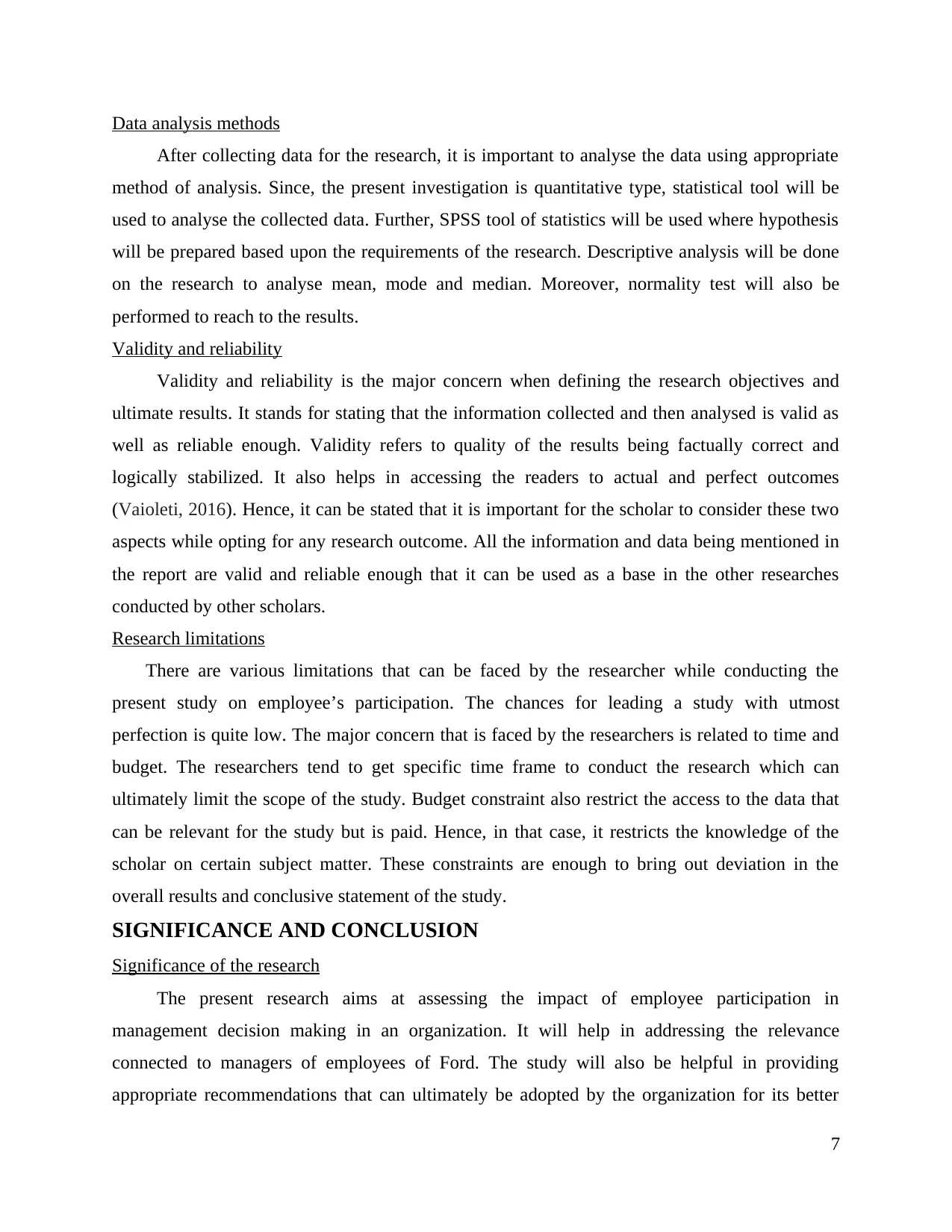
Data analysis methods
After collecting data for the research, it is important to analyse the data using appropriate
method of analysis. Since, the present investigation is quantitative type, statistical tool will be
used to analyse the collected data. Further, SPSS tool of statistics will be used where hypothesis
will be prepared based upon the requirements of the research. Descriptive analysis will be done
on the research to analyse mean, mode and median. Moreover, normality test will also be
performed to reach to the results.
Validity and reliability
Validity and reliability is the major concern when defining the research objectives and
ultimate results. It stands for stating that the information collected and then analysed is valid as
well as reliable enough. Validity refers to quality of the results being factually correct and
logically stabilized. It also helps in accessing the readers to actual and perfect outcomes
(Vaioleti, 2016). Hence, it can be stated that it is important for the scholar to consider these two
aspects while opting for any research outcome. All the information and data being mentioned in
the report are valid and reliable enough that it can be used as a base in the other researches
conducted by other scholars.
Research limitations
There are various limitations that can be faced by the researcher while conducting the
present study on employee’s participation. The chances for leading a study with utmost
perfection is quite low. The major concern that is faced by the researchers is related to time and
budget. The researchers tend to get specific time frame to conduct the research which can
ultimately limit the scope of the study. Budget constraint also restrict the access to the data that
can be relevant for the study but is paid. Hence, in that case, it restricts the knowledge of the
scholar on certain subject matter. These constraints are enough to bring out deviation in the
overall results and conclusive statement of the study.
SIGNIFICANCE AND CONCLUSION
Significance of the research
The present research aims at assessing the impact of employee participation in
management decision making in an organization. It will help in addressing the relevance
connected to managers of employees of Ford. The study will also be helpful in providing
appropriate recommendations that can ultimately be adopted by the organization for its better
7
After collecting data for the research, it is important to analyse the data using appropriate
method of analysis. Since, the present investigation is quantitative type, statistical tool will be
used to analyse the collected data. Further, SPSS tool of statistics will be used where hypothesis
will be prepared based upon the requirements of the research. Descriptive analysis will be done
on the research to analyse mean, mode and median. Moreover, normality test will also be
performed to reach to the results.
Validity and reliability
Validity and reliability is the major concern when defining the research objectives and
ultimate results. It stands for stating that the information collected and then analysed is valid as
well as reliable enough. Validity refers to quality of the results being factually correct and
logically stabilized. It also helps in accessing the readers to actual and perfect outcomes
(Vaioleti, 2016). Hence, it can be stated that it is important for the scholar to consider these two
aspects while opting for any research outcome. All the information and data being mentioned in
the report are valid and reliable enough that it can be used as a base in the other researches
conducted by other scholars.
Research limitations
There are various limitations that can be faced by the researcher while conducting the
present study on employee’s participation. The chances for leading a study with utmost
perfection is quite low. The major concern that is faced by the researchers is related to time and
budget. The researchers tend to get specific time frame to conduct the research which can
ultimately limit the scope of the study. Budget constraint also restrict the access to the data that
can be relevant for the study but is paid. Hence, in that case, it restricts the knowledge of the
scholar on certain subject matter. These constraints are enough to bring out deviation in the
overall results and conclusive statement of the study.
SIGNIFICANCE AND CONCLUSION
Significance of the research
The present research aims at assessing the impact of employee participation in
management decision making in an organization. It will help in addressing the relevance
connected to managers of employees of Ford. The study will also be helpful in providing
appropriate recommendations that can ultimately be adopted by the organization for its better
7
⊘ This is a preview!⊘
Do you want full access?
Subscribe today to unlock all pages.

Trusted by 1+ million students worldwide
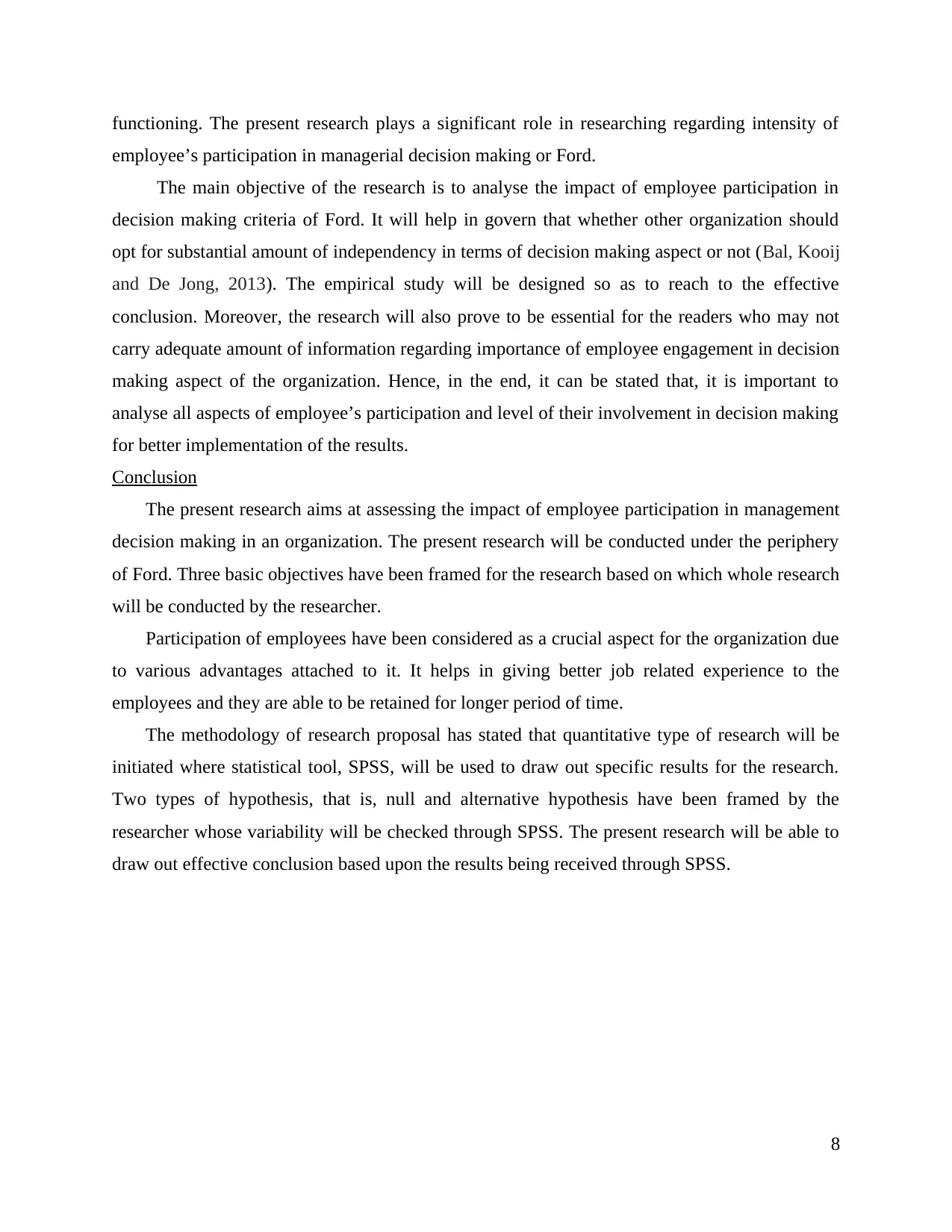
functioning. The present research plays a significant role in researching regarding intensity of
employee’s participation in managerial decision making or Ford.
The main objective of the research is to analyse the impact of employee participation in
decision making criteria of Ford. It will help in govern that whether other organization should
opt for substantial amount of independency in terms of decision making aspect or not (Bal, Kooij
and De Jong, 2013). The empirical study will be designed so as to reach to the effective
conclusion. Moreover, the research will also prove to be essential for the readers who may not
carry adequate amount of information regarding importance of employee engagement in decision
making aspect of the organization. Hence, in the end, it can be stated that, it is important to
analyse all aspects of employee’s participation and level of their involvement in decision making
for better implementation of the results.
Conclusion
The present research aims at assessing the impact of employee participation in management
decision making in an organization. The present research will be conducted under the periphery
of Ford. Three basic objectives have been framed for the research based on which whole research
will be conducted by the researcher.
Participation of employees have been considered as a crucial aspect for the organization due
to various advantages attached to it. It helps in giving better job related experience to the
employees and they are able to be retained for longer period of time.
The methodology of research proposal has stated that quantitative type of research will be
initiated where statistical tool, SPSS, will be used to draw out specific results for the research.
Two types of hypothesis, that is, null and alternative hypothesis have been framed by the
researcher whose variability will be checked through SPSS. The present research will be able to
draw out effective conclusion based upon the results being received through SPSS.
8
employee’s participation in managerial decision making or Ford.
The main objective of the research is to analyse the impact of employee participation in
decision making criteria of Ford. It will help in govern that whether other organization should
opt for substantial amount of independency in terms of decision making aspect or not (Bal, Kooij
and De Jong, 2013). The empirical study will be designed so as to reach to the effective
conclusion. Moreover, the research will also prove to be essential for the readers who may not
carry adequate amount of information regarding importance of employee engagement in decision
making aspect of the organization. Hence, in the end, it can be stated that, it is important to
analyse all aspects of employee’s participation and level of their involvement in decision making
for better implementation of the results.
Conclusion
The present research aims at assessing the impact of employee participation in management
decision making in an organization. The present research will be conducted under the periphery
of Ford. Three basic objectives have been framed for the research based on which whole research
will be conducted by the researcher.
Participation of employees have been considered as a crucial aspect for the organization due
to various advantages attached to it. It helps in giving better job related experience to the
employees and they are able to be retained for longer period of time.
The methodology of research proposal has stated that quantitative type of research will be
initiated where statistical tool, SPSS, will be used to draw out specific results for the research.
Two types of hypothesis, that is, null and alternative hypothesis have been framed by the
researcher whose variability will be checked through SPSS. The present research will be able to
draw out effective conclusion based upon the results being received through SPSS.
8
Paraphrase This Document
Need a fresh take? Get an instant paraphrase of this document with our AI Paraphraser
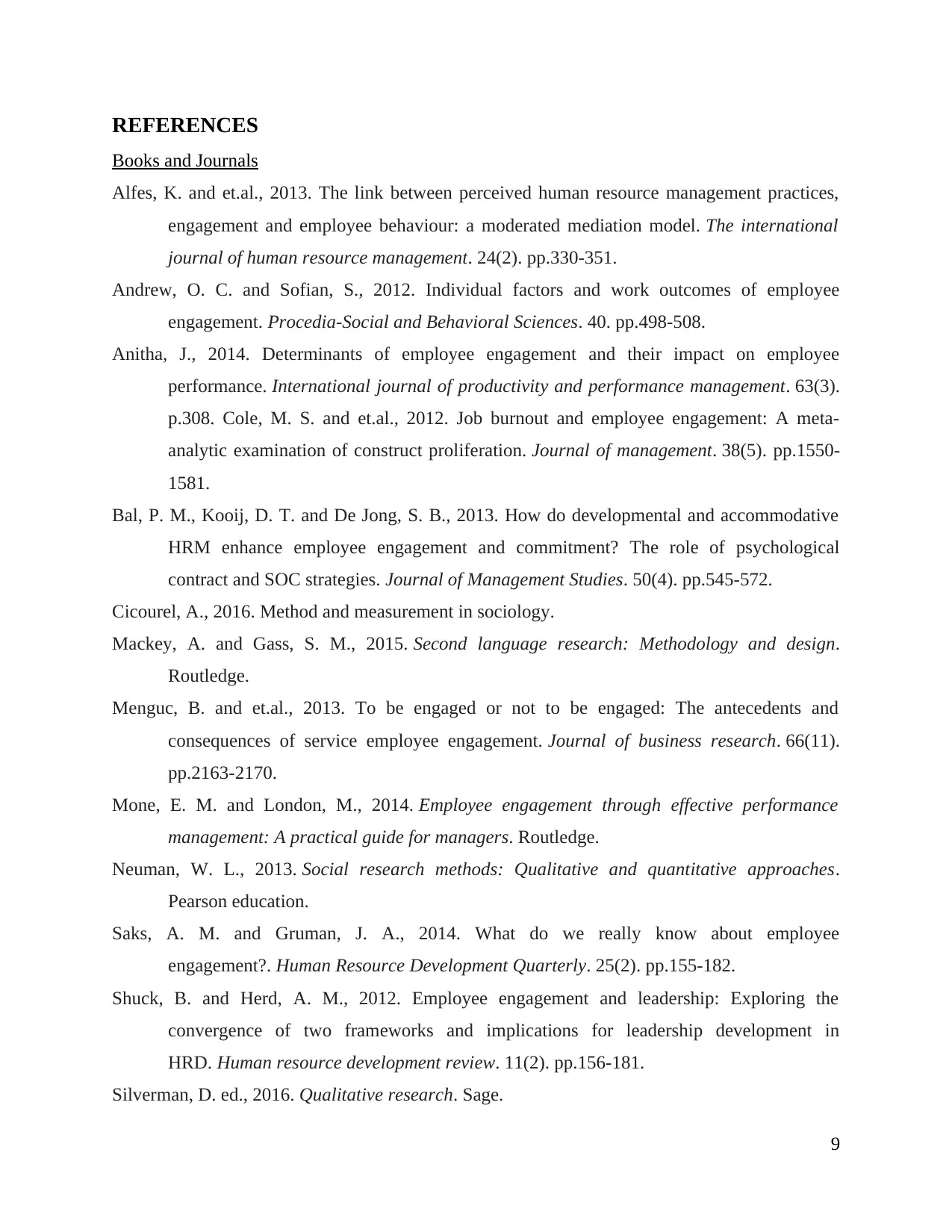
REFERENCES
Books and Journals
Alfes, K. and et.al., 2013. The link between perceived human resource management practices,
engagement and employee behaviour: a moderated mediation model. The international
journal of human resource management. 24(2). pp.330-351.
Andrew, O. C. and Sofian, S., 2012. Individual factors and work outcomes of employee
engagement. Procedia-Social and Behavioral Sciences. 40. pp.498-508.
Anitha, J., 2014. Determinants of employee engagement and their impact on employee
performance. International journal of productivity and performance management. 63(3).
p.308. Cole, M. S. and et.al., 2012. Job burnout and employee engagement: A meta-
analytic examination of construct proliferation. Journal of management. 38(5). pp.1550-
1581.
Bal, P. M., Kooij, D. T. and De Jong, S. B., 2013. How do developmental and accommodative
HRM enhance employee engagement and commitment? The role of psychological
contract and SOC strategies. Journal of Management Studies. 50(4). pp.545-572.
Cicourel, A., 2016. Method and measurement in sociology.
Mackey, A. and Gass, S. M., 2015. Second language research: Methodology and design.
Routledge.
Menguc, B. and et.al., 2013. To be engaged or not to be engaged: The antecedents and
consequences of service employee engagement. Journal of business research. 66(11).
pp.2163-2170.
Mone, E. M. and London, M., 2014. Employee engagement through effective performance
management: A practical guide for managers. Routledge.
Neuman, W. L., 2013. Social research methods: Qualitative and quantitative approaches.
Pearson education.
Saks, A. M. and Gruman, J. A., 2014. What do we really know about employee
engagement?. Human Resource Development Quarterly. 25(2). pp.155-182.
Shuck, B. and Herd, A. M., 2012. Employee engagement and leadership: Exploring the
convergence of two frameworks and implications for leadership development in
HRD. Human resource development review. 11(2). pp.156-181.
Silverman, D. ed., 2016. Qualitative research. Sage.
9
Books and Journals
Alfes, K. and et.al., 2013. The link between perceived human resource management practices,
engagement and employee behaviour: a moderated mediation model. The international
journal of human resource management. 24(2). pp.330-351.
Andrew, O. C. and Sofian, S., 2012. Individual factors and work outcomes of employee
engagement. Procedia-Social and Behavioral Sciences. 40. pp.498-508.
Anitha, J., 2014. Determinants of employee engagement and their impact on employee
performance. International journal of productivity and performance management. 63(3).
p.308. Cole, M. S. and et.al., 2012. Job burnout and employee engagement: A meta-
analytic examination of construct proliferation. Journal of management. 38(5). pp.1550-
1581.
Bal, P. M., Kooij, D. T. and De Jong, S. B., 2013. How do developmental and accommodative
HRM enhance employee engagement and commitment? The role of psychological
contract and SOC strategies. Journal of Management Studies. 50(4). pp.545-572.
Cicourel, A., 2016. Method and measurement in sociology.
Mackey, A. and Gass, S. M., 2015. Second language research: Methodology and design.
Routledge.
Menguc, B. and et.al., 2013. To be engaged or not to be engaged: The antecedents and
consequences of service employee engagement. Journal of business research. 66(11).
pp.2163-2170.
Mone, E. M. and London, M., 2014. Employee engagement through effective performance
management: A practical guide for managers. Routledge.
Neuman, W. L., 2013. Social research methods: Qualitative and quantitative approaches.
Pearson education.
Saks, A. M. and Gruman, J. A., 2014. What do we really know about employee
engagement?. Human Resource Development Quarterly. 25(2). pp.155-182.
Shuck, B. and Herd, A. M., 2012. Employee engagement and leadership: Exploring the
convergence of two frameworks and implications for leadership development in
HRD. Human resource development review. 11(2). pp.156-181.
Silverman, D. ed., 2016. Qualitative research. Sage.
9
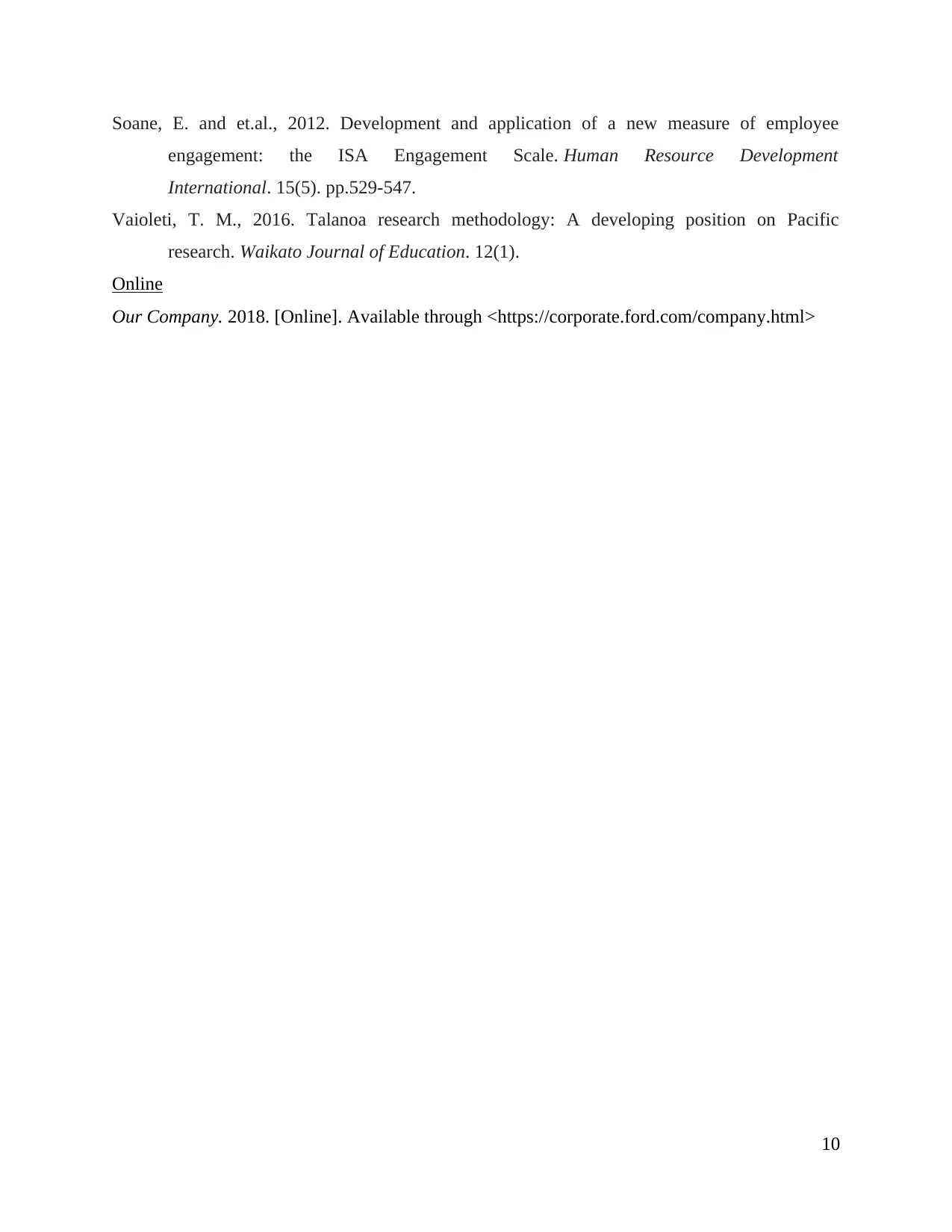
Soane, E. and et.al., 2012. Development and application of a new measure of employee
engagement: the ISA Engagement Scale. Human Resource Development
International. 15(5). pp.529-547.
Vaioleti, T. M., 2016. Talanoa research methodology: A developing position on Pacific
research. Waikato Journal of Education. 12(1).
Online
Our Company. 2018. [Online]. Available through <https://corporate.ford.com/company.html>
10
engagement: the ISA Engagement Scale. Human Resource Development
International. 15(5). pp.529-547.
Vaioleti, T. M., 2016. Talanoa research methodology: A developing position on Pacific
research. Waikato Journal of Education. 12(1).
Online
Our Company. 2018. [Online]. Available through <https://corporate.ford.com/company.html>
10
⊘ This is a preview!⊘
Do you want full access?
Subscribe today to unlock all pages.

Trusted by 1+ million students worldwide
1 out of 13
Related Documents
Your All-in-One AI-Powered Toolkit for Academic Success.
+13062052269
info@desklib.com
Available 24*7 on WhatsApp / Email
![[object Object]](/_next/static/media/star-bottom.7253800d.svg)
Unlock your academic potential
Copyright © 2020–2025 A2Z Services. All Rights Reserved. Developed and managed by ZUCOL.




